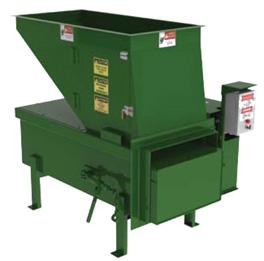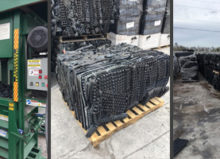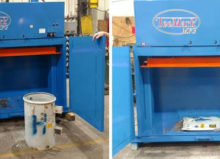What is a Chute Fed Trash Compactor?
 A Chute Fed Trash Compactor is employed as either a Container Packer or a Bag Packer and is traditionally used in multi-stories buildings, hi rise buildings, hospitals, resorts and as Apartment Trash Compactors.
A Chute Fed Trash Compactor is employed as either a Container Packer or a Bag Packer and is traditionally used in multi-stories buildings, hi rise buildings, hospitals, resorts and as Apartment Trash Compactors.
Apartment Compactors are designed to solve those extra tight space problems. The compactor packs into a 2yd or 3yd front load or rear load container where overall space utilization is critical. These powerful units are the perfect solution for high-rise apartments, hotels, hospitals, office buildings and anywhere else trash space is extremely limited.
Units can be equipped with high-rise chute hoppers, ground feed hoppers and any other special installation solution requirement. They can be equipped with single side latching for easy and quick container removal.
Frequently asked Questions
Who would benefit from a Chute Fed Trash Compactor?
High-Rise Apartments, Hospitals, Nursing Homes, Healthcare Facilities, Hotels, Resorts, Office Buildings, Dormitories and anywhere else trash room space is extremely limited.
What material can you compact?
Residential type refuse, mix waste and mixed garbage.
How much footprint does a Chute Fed Trash Compactor need?
- CA-.5 Overall Length 72″, Overall Width 38 1/2″, Overall Height 41 1/2″
- CS-.5 Overall Length 48″, Overall Width 39 3/4″, Overall Height 41 1/2″
How much does a Chute Fed Trash Compactor weigh?
- CA-.5 – 1,840 lbs.
- CS-.5 – 1186 lbs.
How does a Chute Fed Trash Compactor ship?
On a flatbed truck or LTL
How do you unload a Chute Fed Trash Compactor from the truck?
A fork-lift is the most used machine for unloading the vertical baler from the shipping truck. The lifting equipment must be designed for lifting the weight of the crusher.
How do you install a Chute Fed Trash Compactor: concrete, weather, electrical, breather cap, press head?
- Unpack the compactor: Remove all packing wrap and material and discard. Remove the shipping bolts holding the hydraulic power unit in place and set the unit aside. Remove and discard the steel strap and packing material holding the control box in place. Do not mount the control box at this time.
- Position the packer directly below the refuse chute being careful that the chute is centered directly over the hopper. If the floor is uneven it may be necessary to shim one or more of the mounting pads.
- Install lag bolts into the concrete floor using the largest size that will fit through the holes in the mounting pads.
- Install the control box onto the brackets using the hardware provided.
- Position power pack on the same side of the packer as the control box, and lag bolt it to the concrete floor. Connect hydraulic hoses from the compactor to power pack mating the color coded. ends. Fill power pack reservoir with hydraulic fluid to the top mark on dipstick (approximately 10 gallons). Use hydraulic fluid grade AW46 or equivalent.
- Connect electrical power to motor starter on the hydraulic power pack as per wiring diagram. Turn on power at the main disconnect switch. Ensure that power is off to the power pack motor by pushing in the red “Emergency Stop/Start” switch on the control box. Remove the cover from the electric motor starter and jog the motor by manually actuating the starter to determine the rotation of the motor. Rotation should be in accordance with the arrow on the motor and/or pump. Note: Serious damage may result if the motor is run for more than 1 second in the wrong direction or without oil. To change the rotation direction, turn off power at main disconnect switch and reverse any two incoming power wires at the starter. Turn power back on and repeat jog procedure.
- After completing steps 1 through 6 it is recommended that the following checklist be observed before turning equipment over to the customer:
- a) Verify that the hydraulic oil level is correct (between ¾ and full on the dipstick with full cylinder retraction).
- b) Cycle the compactor in all modes of operation, at compaction pressures if possible.
- c) Cycle the compactor numerous times and check for oil leaks and excessive heating of the power unit.
- Operate packer in accordance with Operating Instructions.
How Does a Chute Fed Compactor Work?
The Compactor receives refuse from the chute via the hopper on top and directs it to the compaction chamber. A photoelectric sensor detects the refuse and initiates the compaction cycle. fully automatic models will function without the intervention of operating personnel until the wheeled container is full, at which time the unit will turn off, and illuminate the “Unload Light” to alert operators that the container needs to be removed and replaced. The compaction cycle begins with the ram located in the rear position. Upon sensing the presence of trash, the ram travels forward pushing the trash into the container, reverses, moves to the rear, and shuts off, awaiting the next load from the building chute. Once the container is full, the ram stops in the forward position.
Containers
Will your compaction containers be front load or rear load? Do they roll out to the street (do you have direct access to the street)? Does the truck picks them up and throws them over the cab of the truck or picks them up from the rear of the truck?
Container Size and Quantity
How many compaction containers will you need (we recommend two)?
- 2 Cubic Yard, Rear or Front Load
- 3 Cubic Yard, Rear or Front Load
Electrical Options
- Single Phase Voltage Option (230V)
- Three Phase Voltage Options (208V, 230V, 460V, 575V)
Hydraulic oil
- Biodegradable Oil
- Hydraulic Oil & ATF Blend – 50%
Safety System Included
- UL/CUL Listed Control Panel
- ANSI Z245.2 & ANSI Z245.21 Compliant
- Quiet Operating Vane Pump
Preventative Maintenance
The following preventative maintenance procedure steps are recommended for all Compactors.
WEEKLY – To be performed by Building Maintenance Personnel.
- Check oil reservoir level (should be between ¾ and full-on dip stick). Examine equipment for possible hydraulic leaks.
- Clean Photoelectric Sensor unit and the Reflector.
- During container replacement/change over, flush down hopper with hot water.
QUARTERLY – To be performed by Authorized Service Representative.
- Check oil for water contamination (replace oil if necessary).
- Check strainers for clogging (clean or replace if necessary).
- Check pressure switch(s) and pressure relief valve settings.
- Observe the packer through several cycles at compaction pressures and check for leaks and proper operation sequence.
ANNUALLY – To be performed by Authorized Service Representative.
- Drain, flush and refill hydraulic system with clean hydraulic oil and replace suction strainer.
- Grease electric motor (grease fittings on each end of motor).
- Grease Hydraulic Cylinders (grease fitting on mtg. Pin cross tube) (see Fig. H2).
- Inspect all hydraulic hoses, lines, and fittings for wear and leakage.
- Inspect all wiring and control box for worn or cut insulation and loose connections.
Options available
- Rear Flared Hopper w/ Access Door
- Additional 2yd Capacity Front Load Container
- Additional 3yd Capacity Front Load Container
- Fold Down Closure for Container
- Swivel Casters for Container – Two Lockable
- 75% & 100% Full Lights Combined
- Multi-Cycle Operation, 3 Cycles (no selector switch)
- Auto-Cycle Operation w/ Photocell
- Biodegradable Oil
- Hydraulic Oil & ATF Blend – 50%
- Sonozaire Odor Neutralizer
- Single Phase Voltage Option (230V)
- Three Phase Voltage Options (208V, 230V, 460V, 575V)
J.V. Manufacturing CRAM-A-LOT® Apartment Compactors are designed to solve those extra tight space problems. The compactor packs into a 2yd or 3yd front load or rear load container where overall space utilization is critical. These powerful units are the perfect solution for high-rise apartments, hotels, hospitals, office buildings and anywhere else trash space is limited.
Precision Machinery Systems, Inc Model 520 Series Trash Compactors are normally installed in street level trash rooms and used in conjunction with a trash chute system in Hi Rise buildings. Operation is automatic, with the unit being activated by an electric eye which senses trash in the loading hopper. These units are typically used with two cubic yard compaction containers which, when full, are wheeled outside for pick-up by a commercial trash service. The unit automatically shuts down when the container is full.
Precision Machinery Systems, Inc Model XM Series Trash Compactors are bag packers normally installed in below grade trash rooms, used in conjunction with a trash chute system in Hi Rise Apartment Buildings. The units can also be hand fed.
These Trash Compactors are designed for multi-story buildings, receiving trash from the building trash chute.



